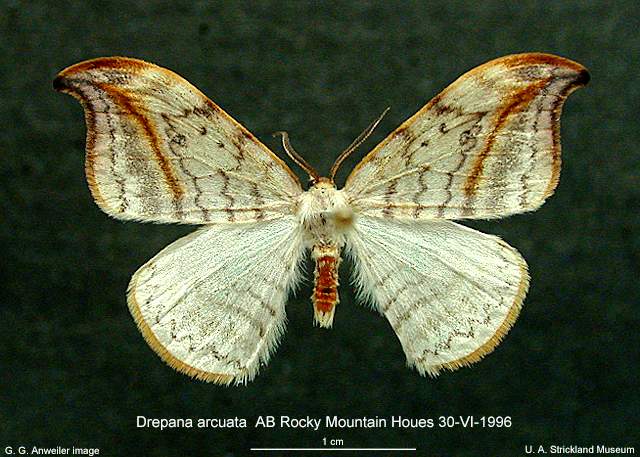Species Details
Drepana arcuata
University of Alberta E.H. Strickland Entomological Museum Read more about this collection »
Common NameArched Hooktip
SeasonalityIn Alberta adults are on the wing from mid-May through late-July.
IdentificationHooktips are medium-size broad-winged geometrid-like moths with the forewing apex drawn out into a prominent curved point. The Arched Hook tip (2.4- 4.0 cm wingspan) is yellow-brown or light tan. The forewings are crossed by a series of toothed fine brown lines, with a darker curved line running from the lower margin to the hooked apex, and with two small dark dots in the discal area. The outer margins of the forewings are smooth (toothed in D. bilineata). The hindwings are white or very pale yellow-brown, faintly and incompletely crossed by a series of fine light brown bands. The sexes are similar. The related Two-lined Hooktip (D. bilineata) has darker tan forewings with toothed margins, each crossed by only two fine dark brown lines. The hindwings are unmarked or nearly so. The Rose Hooktip (Oreta rosea) is darker and two-toned dark brown or purple-brown and yellow.
Scientific Name
Drepana arcuata
Common Name
Arched Hooktip
Habitat
Deciduous woodland with birch or alder.
Seasonality
In Alberta adults are on the wing from mid-May through late-July.
Identification
Hooktips are medium-size broad-winged geometrid-like moths with the forewing apex drawn out into a prominent curved point. The Arched Hook tip (2.4- 4.0 cm wingspan) is yellow-brown or light tan. The forewings are…
Hooktips are medium-size broad-winged geometrid-like moths with the forewing apex drawn out into a prominent curved point. The Arched Hook tip (2.4- 4.0 cm wingspan) is yellow-brown or light tan. The forewings are crossed by a series of toothed fine brown lines, with a darker curved line running from the lower margin to the hooked apex, and with two small dark dots in the discal area. The outer margins of the forewings are smooth (toothed in D. bilineata). The hindwings are white or very pale yellow-brown, faintly and incompletely crossed by a series of fine light brown bands. The sexes are similar. The related Two-lined Hooktip (D. bilineata) has darker tan forewings with toothed margins, each crossed by only two fine dark brown lines. The hindwings are unmarked or nearly so. The Rose Hooktip (Oreta rosea) is darker and two-toned dark brown or purple-brown and yellow.
Life History
The Arched Hookedtip is nocturnal and comes to light. There is a single brood each year. The larvae are solitary defoliators.
Conservation
A fairly common widespread species; no concerns.
Diet Info
No specific Alberta data. Elsewhere in Canada reported to utilize White Birch (Betula papyrifera) and alder (Alnus sp.) as larval hosts (Prentice, 1963).
Range
Newfoundland to Vancouver Island, south to at least the Carolinas and California (?). In Alberta it can be found throughout the Boreal forest region, north to Bitumount and Zama, as well as in the foothills and…
Newfoundland to Vancouver Island, south to at least the Carolinas and California (?). In Alberta it can be found throughout the Boreal forest region, north to Bitumount and Zama, as well as in the foothills and mountain regions.
References
Author
Covell, C. V., Jr.
Title
A field guide to the moths of eastern North America.
Publication Date
1984
Pages
496
Author
Prentice, R. M.
Title
Forest Lepidoptera of Canada. (1962)
Publication Date
1962
Volume
2
Pages
281
Author
Ives, W. G. H. and H. R. Wong
Title
Tree and shrub insects of the prairie provinces
Publication Date
1988
Pages
327
Specimen Information
There are 49 specimens of this Species.
UASM7003 - Drepana arcuata
University of Alberta E.H. Strickland Entomological Museum
Place CollectedCanada: Alberta, Tofield
Collected BySchmidt, B. C.
Date Collected2000-06-21
UASM24643 - Drepana arcuata
University of Alberta E.H. Strickland Entomological Museum
Place CollectedCanada: Alberta, Edmonton
Collected ByAnweiler, G. G.
Date Collected1998-05-19
UASM28809 - Drepana arcuata
University of Alberta E.H. Strickland Entomological Museum
Place CollectedCanada: Alberta, Edmonton
Collected ByLawrie, D.
Date Collected1995-06-05
UASM28810 - Drepana arcuata
University of Alberta E.H. Strickland Entomological Museum
Place CollectedCanada: Alberta, Edmonton
Collected ByLawrie, D.
Date Collected1995-06-11
UASM28811 - Drepana arcuata
University of Alberta E.H. Strickland Entomological Museum
Place CollectedCanada: Alberta, Wagner Natural Area
Collected ByLawrie, D.
Date Collected1998-05-28
UASM28812 - Drepana arcuata
University of Alberta E.H. Strickland Entomological Museum
Place CollectedCanada: Alberta, Edmonton
Collected ByLawrie, D.
Date Collected1998-06-06
UASM28813 - Drepana arcuata
University of Alberta E.H. Strickland Entomological Museum
Place CollectedCanada: Alberta, Edmonton
Collected ByLawrie, D.
Date Collected1998-06-06
UASM35651 - Drepana arcuata
University of Alberta E.H. Strickland Entomological Museum
Place CollectedCanada: Alberta, Edmonton
Date Collected1917-07-01
UASM35652 - Drepana arcuata
University of Alberta E.H. Strickland Entomological Museum
Place CollectedCanada: Alberta, Edmonton
Date Collected1918-06-22
UASM35653 - Drepana arcuata
University of Alberta E.H. Strickland Entomological Museum
Place CollectedCanada: Alberta, Edmonton
Date Collected1917-07-02
UASM35654 - Drepana arcuata
University of Alberta E.H. Strickland Entomological Museum
Place CollectedCanada: Alberta, Edmonton
Date Collected1916-06-26
UASM35700 - Drepana arcuata
University of Alberta E.H. Strickland Entomological Museum
Place CollectedCanada: Alberta, Edmonton
Date Collected1917-06-27
UASM35701 - Drepana arcuata
University of Alberta E.H. Strickland Entomological Museum
Place CollectedCanada: Alberta, Edmonton
Date Collected1918-06-09
UASM35702 - Drepana arcuata
University of Alberta E.H. Strickland Entomological Museum
Place CollectedCanada: Alberta, Edmonton
Collected ByMackie, Donald
Date Collected1916-06-26
UASM35703 - Drepana arcuata
University of Alberta E.H. Strickland Entomological Museum
Place CollectedCanada: Alberta, Edmonton
Collected ByCarr, F. S.
Date Collected1910-05-06
UASM35704 - Drepana arcuata
University of Alberta E.H. Strickland Entomological Museum
Place CollectedCanada: Alberta, Edmonton
Collected ByMackie, Donald
Date Collected1917-06-15
UASM35705 - Drepana arcuata
University of Alberta E.H. Strickland Entomological Museum
Place CollectedCanada: Alberta, Edmonton
Collected ByBowman, K.
Date Collected1920-07-02
UASM35706 - Drepana arcuata
University of Alberta E.H. Strickland Entomological Museum
Place CollectedCanada: Alberta, Edmonton
Collected ByBowman, K.
Date Collected1920-07-10
UASM35707 - Drepana arcuata
University of Alberta E.H. Strickland Entomological Museum
Place CollectedCanada: Alberta, Edmonton
Collected ByBowman, K.
Date Collected1919-06-20
UASM35708 - Drepana arcuata
University of Alberta E.H. Strickland Entomological Museum
Place CollectedCanada: Alberta, Edmonton
Collected ByBowman, K.
Date Collected1944-06-09
UASM35709 - Drepana arcuata
University of Alberta E.H. Strickland Entomological Museum
Place CollectedCanada: Alberta, Edmonton
Collected ByBowman, K.
Date Collected1933-06-15
